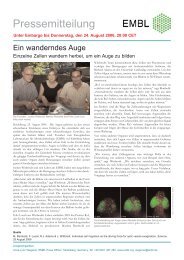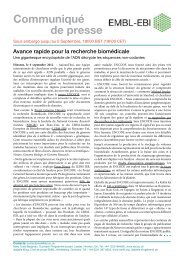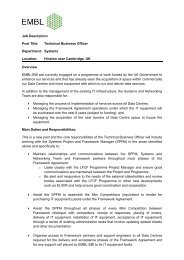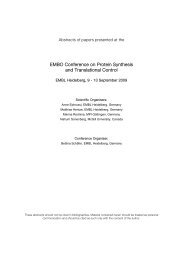Media Clips - EMBL
Media Clips - EMBL
Media Clips - EMBL
You also want an ePaper? Increase the reach of your titles
YUMPU automatically turns print PDFs into web optimized ePapers that Google loves.
DNA study challenges basic ideas in genetics - The Boston Globe<br />
DNA study challenges basic ideas in genetics<br />
Genome 'junk' appears essential<br />
By Colin Nickerson, Globe Staff | June 14, 2007<br />
THIS STORY HAS BEEN FORMATTED FOR EASY PRINTING<br />
A massive international study of the human genome has caused scientists to rethink some of the most basic<br />
concepts of cellular function. Genes, it turns out, may be relatively minor players in genetic processes that are<br />
far more subtle and complicated than previously imagined.<br />
Among the critical findings: A huge amount of DNA long regarded as useless -- and dismissively labeled "junk<br />
DNA" -- now appears to be essential to the regulatory processes that control cells. Also, the regions of DNA<br />
lying between genes may be powerful triggers for diseases -- and may hold the key for potential cures.<br />
The research, published in a set of papers in today's editions of the journals Nature and Genome Research,<br />
raised far more questions than it answered -- and in a sense was a rallying cry for more and deeper research<br />
into the functioning of the genome, often referred to as the "blueprint" for life.<br />
"The instruction manual for life is written in a language we are only just beginning to understand," Francis<br />
Collins, director of the federal government's National Human Genome Research Institute , said at a news<br />
conference yesterday.<br />
Page 1 of 2<br />
Collins' s institute was among the more than 80 research institutions in North America, Europe, Asia, and<br />
Australia that participated in the $42 million, four-year study, whose aim was to analyze 30 million units of<br />
human DNA -- just 1 percent of the entire human genome -- to create an inventory of biologically functional<br />
elements. The project is known as the Encyclopedia of DNA Elements, or ENCODE, and involved an<br />
exhaustive scrutiny of 44 broad "sites" in the human genome, probing not just genes, but all material in the<br />
samples.<br />
"We're finding that a lot of the genome is as mysterious as 'dark matter' in physics; we know it is out there<br />
doing something. The challenge is to find out what and why," said Thomas D. Tullius , professor of chemistry<br />
at Boston University and one of the ENCODE researchers. "There were huge surprises; this research has<br />
upset a lot of thinking about how the genome works."<br />
He added in an interview: "There now appear to be thousands of places in the genome that were long thought<br />
to be useless or meaningless, but which we now see to have a functional role. But we don't really understand<br />
what that role is."<br />
Most startling, according to researchers, is that some areas of the genome looming as crucial are regions that<br />
don't contain specific instructions for making proteins. That recognition amounts to a sea change in basic<br />
biology.<br />
There are about 20,000 genes in the human body. But they are surrounded by other DNA material whose<br />
exact purpose is unclear. Roughly 1 percent of the human genome is thought to be "protein-coding" -- that is,<br />
genes. Another 4 percent had been thought to be "non coding DNA" that serves as on-off switches for the<br />
genes, and the rest was seen as a sort of swamp with no clear purpose.<br />
But the new work suggests that the "control regions" in the DNA are far more extensive, perhaps embracing<br />
more than half of all DNA. Functions thought to be carried out by genes alone now appear to be managed by<br />
multiple, overlapping segments of DNA. In addition, other portions of the genome are believed to be on<br />
standby, as a toolbag to be utilized as humans evolve.<br />
"It's like clutter in the attic," said Collins. "Most of the time, the human genome is operating on the 'first and<br />
second floor,' with 5 percent of the genome doing what needs to be done on a daily basis. But over<br />
http://www.boston.com/news/science/articles/2007/06/14/dna_study_challenges_...<br />
6/14/2007
















